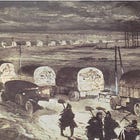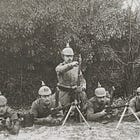Danish Madsen Gun Platoons
Musketen Battalions of the Prussian Army (1915-1917)
In March of 1914, the Infantry Journal [Revue d’Infanterie] of the French Army published an article on the subject of the Danish Army that described, among many other things, bicycle unit armed with Madsen guns. I have yet to find any evidence that the German officers who designed the two Musketen battalions in the summer of 1915 borrowed any ideas from this earlier organization. Nonetheless, I find it hard to imagine that, at a time when Germans kept close tabs on their neighbors to the north, the designers of German units armed with Madsen guns knew nothing of their Danish counterparts.
Commanded by a lieutenant, the Danish unit broke down into two sections, each of which consisted of a pair of squads. Each squad, in turn, consisted of a leader and three three-man teams, each of which employed a single Madsen gun.
Thirty-six of the forty private soldiers in the platoon served in light machine gun teams. Thus, only four men standing in the ranks of the unit performed duties that were not directly related to the care, feeding, and firing of Madsen guns.
Source: Didier and Bertrand’ ‘Le fantassin en campagne dans les principales armées: Danemark’ [‘The Infantryman on Campaign in the Principal Armies: Denmark’] Revue d’Infanterie (March 1914) page 249
To Share, Support, or Subscribe:
For Further Reading:






April was a great movie about Danish bicycle troops in 1940 invasion. Well drilled.
A shame in a way the Danes didn’t mobilize, in another way not as it would have meant more casualties.